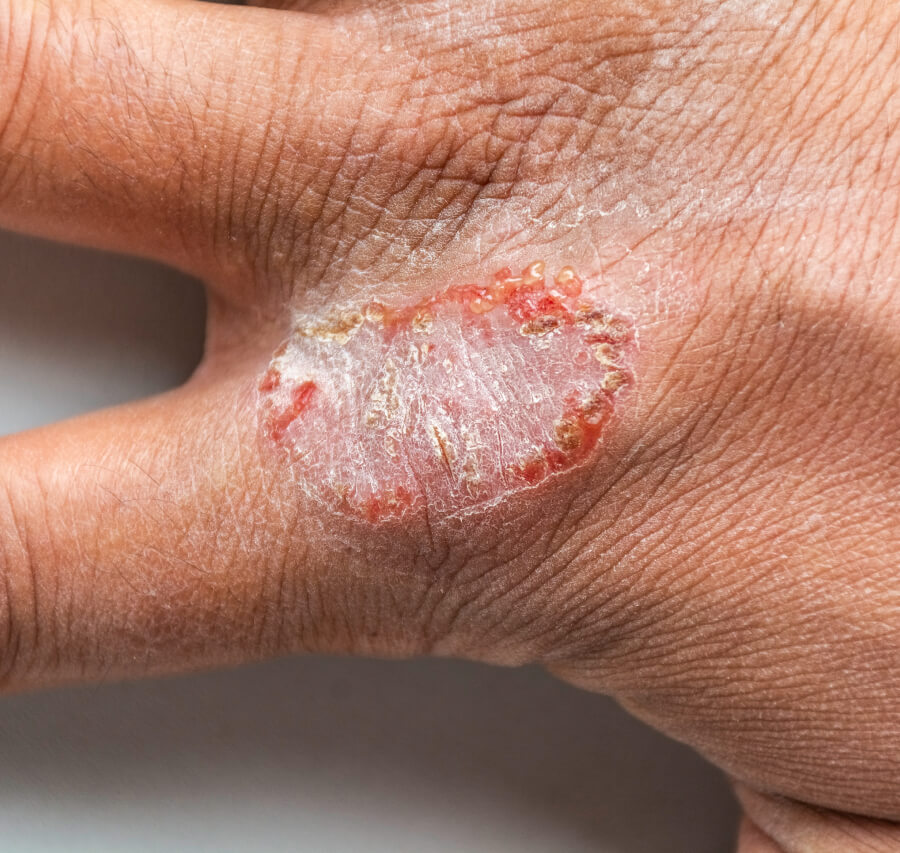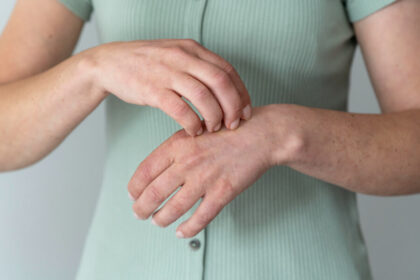Suddenly, a persistent itch interrupts your zen. You take a peek and find a red, scaly patch – the dreaded fungal skin infections.
Imagine this: you’re enjoying a barefoot walk on the beach, feeling the sand squish between your toes. Bliss, right?
While not life-threatening, these uninvited guests can certainly dampen your fun (and aesthetics).
But before you reach for harsh chemicals, let’s explore the fascinating world of fungi and discover natural ways to keep them at bay!
Fungi are everywhere – in the air you breathe, the soil you walk on, and yes, even on your skin.
Most fungi are harmless, some even beneficial, but a few opportunistic ones can cause trouble when given the right conditions.
Think warm, moist environments like sweaty feet, tight clothes, or damp skin folds.
These fungi feed on keratin, a protein found in your skin, hair, and nails, leading to the infamous itchy, scaly patches.
Fungi are remarkable organisms that exist all around us. There are millions of fungal species, but only a few hundred can cause infections in humans.
From the damp forest floor to the crevices of our own skin, they play an essential role in the ecosystem. However, when these tiny creatures decide to set up camp on our skin, things can get interesting—and sometimes uncomfortable.
What Exactly Is a Fungal Skin Infection?
Fungi are opportunistic. They thrive in warm, moist environments, making areas like sweaty feet, groins, and skin folds their favorite hangouts. But what happens when they overstay their welcome? That’s when fungal skin infections occur.
Common Culprits:
Candidiasis: This yeast infection can pop up in warm, poorly ventilated areas like the buttocks folds or under the breasts. Candida albicans, the most common species, loves to party on your skin.
Scalp Ringworm: Despite the name, it’s not caused by worms. It’s a fungal infection that affects the scalp and hair.
Jock Itch: Not just for athletes! This itchy rash loves the groin area.
Athlete’s Foot: The bane of sandal wearers everywhere.
Yeast Infections: Caused by an overgrowth of Candida albicans, a naturally occurring yeast, these can develop in warm, moist areas like the groin, mouth, and vagina.
How Do You Get Infected?
Fungi are social creatures—they love direct contact. You can catch them from:
Another Person: Sharing towels or close skin-to-skin contact.
Animals: Your furry friends might unwittingly pass them on.
Clothing: That gym mat at your favorite yoga class? Yep, it could harbor fungi.
Hot Tubs and Saunas: Relaxing, but watch out for lurking fungi.
Fungal infections may affect anybody, even those in otherwise good health.
People often breathe in or come into touch with fungal spores without becoming ill since fungi are prevalent in the environment. Nonetheless, these fungi are more likely to induce an infection in those with compromised immune systems “Centers for Disease and Prevention. “Centers for Disease and Prevention“
Symptoms and Signs of Fungal Skin Infections
Fungal skin infections can present with various symptoms and signs depending on the type of fungus involved and the area of the body affected. Some common symptoms and signs include:
Itching (Pruritus): Itching is a hallmark symptom of many fungal skin infections. It can range from mild to severe and may worsen with sweating or heat.
Redness (Erythema): Affected areas of the skin may appear red or inflamed. This can be localized or spread over a larger area.
Rash: Fungal infections often cause a rash characterized by redness, bumps, or patches on the skin. The rash may be flat or raised, and its appearance can vary depending on the type of fungus and the individual’s skin.
Scaling: Scaling or flaking of the skin is common with fungal infections. This can lead to the formation of dry, peeling skin or thick, crusted areas.
Blisters: Some fungal infections, such as tinea pedis (athlete’s foot) or tinea corporis (ringworm), may cause small fluid-filled blisters to develop on the skin.
Cracking and Fissures: In areas where the skin is subjected to friction or moisture, such as between the toes or in the groin area, fungal infections can lead to cracking and fissures.
Oozing and Drainage: In severe cases or when the skin becomes damaged from scratching, fungal infections may result in oozing, weeping, or drainage from the affected area.
Thickened Skin: Chronic fungal infections can cause the skin to become thickened and hardened. This is particularly common in conditions like onychomycosis (fungal nail infection).
Hair Loss: Fungal infections of the scalp, such as tinea capitis, can cause hair loss or thinning in affected areas.
Nail Changes: Fungal infections of the nails (onychomycosis) can cause changes in the appearance of the nails, including yellowing, thickening, crumbling, or detachment from the nail bed.
It’s important to note that these symptoms and signs can vary in severity and may overlap with other skin conditions.
Treatment and Prevention
Topical Antifungals: Creams, lotions, and powders can kick those fungi to the curb.
Oral Antifungal Medications: Sometimes, the infection runs deep, and oral meds are needed.
Keep It Dry: Fungi hate dry environments, so air out those damp spots.
Wear Breathable Fabrics: Let your skin breathe—cotton is your friend.
Good Hygiene: Regular showers and clean clothes go a long way.
Nature’s Arsenal Against Fungus:
Before reaching for chemical anti-fungals, consider these natural allies:
Tea Tree Oil: This powerhouse essential oil has antifungal properties. Dilute it and apply it topically (always do a patch test first!).
Garlic: Not just for vampires! Garlic has natural antifungal compounds. Enjoy it raw, cooked, or even use a topical garlic extract.
Apple Cider Vinegar: The acetic acid in ACV can help create an unfriendly environment for fungi. Dilute it and use it as a soak or compress.
Coconut Oil: Rich in caprylic acid, which exhibits antifungal activity, coconut oil can be applied directly to the affected area.
Probiotics: These gut-friendly bacteria help maintain a healthy immune system, which can indirectly defend against fungal infections. Yogurt, kefir, and fermented foods are your friends!
Remember, an ounce of prevention is worth a pound of cure:
Keep it dry: Fungi thrive in moisture. Dry your feet thoroughly after showers, wear breathable fabrics, and avoid tight shoes.
Change your socks and shoes regularly: Especially after sweating or being in moist environments.
Don’t share personal items: Towels, razors, and nail clippers can harbor fungi.
Boost your immune system: A healthy immune system is better equipped to fight off infections. Eat a balanced ‘;diet, exercise regularly, and get enough sleep.
Conclusion:
Fungal skin infections are common conditions caused by various types of fungi. They can affect anyone, regardless of age or gender, and often present with symptoms such as itching, redness, rash, scaling, and blisters.
While these infections are usually not serious, they can cause discomfort and may lead to complications if left untreated. Fortunately, many effective treatments are available, ranging from over-the-counter antifungal creams to prescription medications.
If you suspect you have a fungal skin infection, it’s essential to consult with a healthcare professional for an accurate diagnosis and appropriate treatment plan. With proper care and treatment, most fungal skin infections can be successfully managed and resolved.
FAQs:
Are fungal skin infections contagious?
Yes, many fungal skin infections are contagious and can spread through direct contact with infected individuals or contaminated surfaces.
It’s essential to practice good hygiene, avoid sharing personal items like towels and clothing, and seek treatment promptly to prevent the spread of infection.
Can fungal skin infections affect any part of the body?
Yes, fungal skin infections can affect any part of the body, including the feet (athlete’s foot), groin (jock itch), scalp (tinea capitis), nails (onychomycosis), and body (ringworm). The type of infection and its symptoms may vary depending on the location and type of fungus involved.
How are fungal skin infections diagnosed?
Fungal skin infections are typically diagnosed based on clinical evaluation, medical history, and sometimes laboratory tests. Healthcare professionals may perform skin scrapings, cultures, or microscopic examinations of skin samples to identify the type of fungus causing the infection.
What are the risk factors for developing fungal skin infections?
Risk factors for fungal skin infections include warm and humid environments, sweating, weakened immune system, poor hygiene, sharing contaminated items, wearing tight or non-breathable clothing, and having certain medical conditions such as diabetes or obesity.
Can fungal skin infections be prevented?
Yes, fungal skin infections can often be prevented by practicing good hygiene, keeping the skin clean and dry, wearing breathable clothing, avoiding sharing personal items, wearing protective footwear in public places like locker rooms and swimming pools, and treating underlying medical conditions that may increase the risk of infection.
How long does it take to treat a fungal skin infection?
The duration of treatment for fungal skin infections varies depending on the type and severity of the infection, as well as the chosen treatment approach.
Some infections may clear up with a few weeks of topical antifungal treatment, while others may require oral medications or longer-term therapy. It’s essential to follow the healthcare professional’s recommendations and complete the full course of treatment to ensure the infection is fully eradicated.





